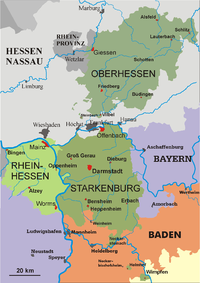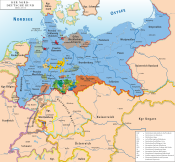Grand Duchy of Hesse
This article needs additional citations for verification. (June 2021) |
Grand Duchy of Hesse and by Rhine Großherzogtum Hessen und bei Rhein | |||||||||
|---|---|---|---|---|---|---|---|---|---|
| 1806–1918 | |||||||||
| Motto: Gott, Ehre, Vaterland "God, Honour, Fatherland" | |||||||||
| Anthem: Hessenlied "Song of Hesse" | |||||||||
 The Grand Duchy of Hesse within the German Empire | |||||||||
| Status |
| ||||||||
| Capital | Darmstadt | ||||||||
| Common languages | Hessian | ||||||||
| Religion | |||||||||
| Government | Constitutional Monarchy | ||||||||
| Grand Duke | |||||||||
• 1806–1830 | Louis I | ||||||||
• 1830–1848 | Louis II | ||||||||
• 1848–1877 | Louis III | ||||||||
• 1877–1892 | Louis IV | ||||||||
• 1892–1918 | Ernest Louis | ||||||||
| Minister-President | |||||||||
• 1821–1829 | Carl Grolman (first) | ||||||||
• 1906–1918 | Christian Ewald (last) | ||||||||
| Legislature | Landtag | ||||||||
• Upper Chamber | Herrenhaus | ||||||||
• Lower Chamber | Abgeordnetenhaus | ||||||||
| Historical era | Napoleonic Wars / WWI | ||||||||
• Established | 13 August 1806 | ||||||||
• German Revolution | 9 November 1918 | ||||||||
| Area | |||||||||
| 1910[1] | 7,688.36 km2 (2,968.49 sq mi) | ||||||||
| Population | |||||||||
• 1910[1] | 1,282,051 | ||||||||
| |||||||||
The Grand Duchy of Hesse and by Rhine (German: Großherzogtum Hessen und bei Rhein) was a grand duchy in western Germany that existed from 1806 (the period of German mediatisation) to the end of the German Empire in 1918. The grand duchy originally formed on the basis of the Landgraviate of Hesse-Darmstadt in 1806 as the Grand Duchy of Hesse (German: Großherzogtum Hessen). After the end of the Napoleonic Wars in 1815, it changed its name in 1816 to distinguish itself from the Electorate of Hesse, which had formed from neighboring Hesse-Kassel. Colloquially, the grand duchy continued to be known by its former name of Hesse-Darmstadt. It joined the German Empire in 1871 and became a republic after the German defeat in World War I in 1918.
History[]
Hesse-Darmstadt was a member of Napoleon's Confederation of the Rhine during the Napoleonic Wars. Rapidly expanding during the mediatizations, Hesse-Darmstadt became an amalgamation of smaller German states, such as the Electorate of Cologne. The legal patchwork of the state culminated in a decree issued on 1 October 1806 by Louis I. The old territorial estates were abolished, which altered Hesse-Darmstadt "from a mosaic of patrimonial fragments into a centralized, absolute monarchy."[2] The Duchy of Westphalia, which Hesse-Darmstadt had received in 1803, was ceded to the Kingdom of Prussia during the Congress of Vienna. However, Hesse-Darmstadt was compensated with some territory on the western bank of the Rhine, including the important federal fortress at Mainz.

The neighboring Landgraviate of Hesse-Kassel had backed Prussia against Napoleon and was absorbed into the Kingdom of Westphalia. At the Congress of Vienna, Hesse-Kassel was reestablished as the Electorate of Hesse. To distinguish the two Hessian states, the grand duchy changed its name to the Grand Duchy of Hesse and by Rhine (German: Großherzogtum Hessen und bei Rhein) in 1816.
In 1867, the northern half of the Grand Duchy (Upper Hesse) became a part of the North German Confederation, while the half of the Grand Duchy south of the Main (Starkenburg and Rhenish Hesse) remained outside. In 1871, it became a constituent state of the German Empire. The last Grand Duke, Ernst Ludwig (a grandson of Queen Victoria and brother to Empress Alexandra of Russia), was forced from his throne at the end of World War I, and the state was renamed the People's State of Hesse (Volksstaat Hessen).
After World War II, the majority of the state combined with Frankfurt am Main, the Waldeck area (Rhine-Province) and the former Prussian province of Hesse-Nassau to form the new state of Hesse. Excluded were the Montabaur district from Hessen-Nassau and that part of Hessen-Darmstadt on the left bank of the Rhine (Rhenish Hesse), which became part of the Rhineland-Palatinate state. (Bad) Wimpfen—an exclave of Hessen-Darmstadt—became part of Baden-Württemberg, in the district of Sinsheim. After a plebiscite on 29 April 1951, Bad Wimpfen was transferred from Sinsheim district to Heilbronn District. This change to Heilbronn was carried out on 1 May 1952.
Transport[]
Because of the disjointed nature of the state, it did not develop its own state railway to begin with, but set up joint railway projects with its neighbouring states: These were the:
- Main-Neckar Railway with Frankfurt and Baden
- Main-Weser Railway with Frankfurt and Kurhessen
- Frankfurt-Offenbach Local Railway with the Free City of Frankfurt
In addition the state encouraged numerous other projects by the privately owned Hessian Ludwig Railway Company. Finally, in 1876 the state founded its own company, the Grand Duchy of Hesse State Railways, which continued to expand the network until it was finally merged into the Prussian-Hessian Railway Company in 1897.
Subdivisions of Hesse[]

The Grand Duchy of Hesse was divided into three provinces:
- Starkenburg (capital at Darmstadt): Right bank of the Rhine, south of the Main.
- Rhenish Hesse (capital at Mainz): Left bank of the Rhine, territory gained from the Congress of Vienna.
- Upper Hesse (capital at Giessen): North of the Main, separated from Starkenburg by the Free City of Frankfurt.
See also[]
References[]
- ^ Willkommen bei Gemeindeverzeichnis.de
- ^ Hans A. Schmitt. "Germany Without Prussia: A Closer Look at the Confederation of the Rhine." German Studies Review 6, No. 4 (1983), pp 9-39.
External links[]
| Wikimedia Commons has media related to Grand Duchy of Hesse. |
- Grand Duchy of Hesse
- States of the German Empire
- States of the North German Confederation
- States of the German Confederation
- States of the Confederation of the Rhine
- States and territories established in 1806
- States and territories disestablished in 1918
- Former grand duchies
- Former countries





